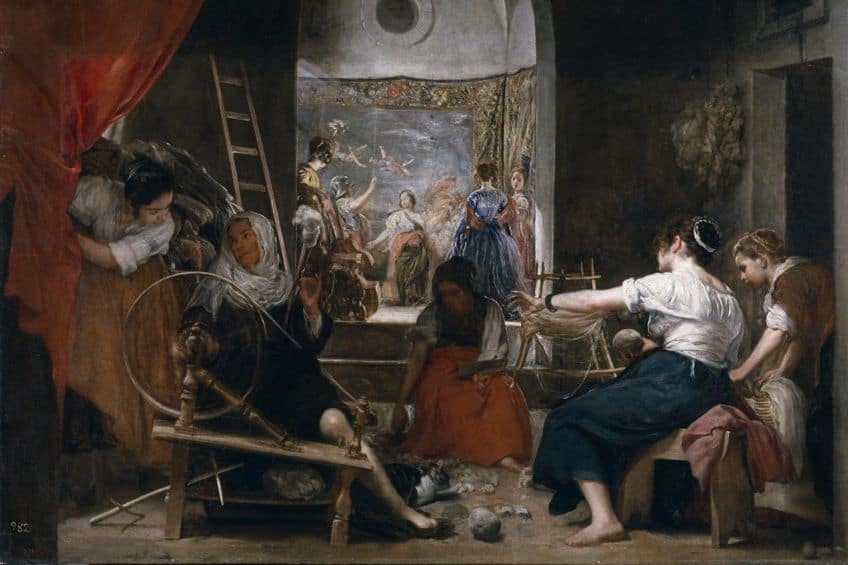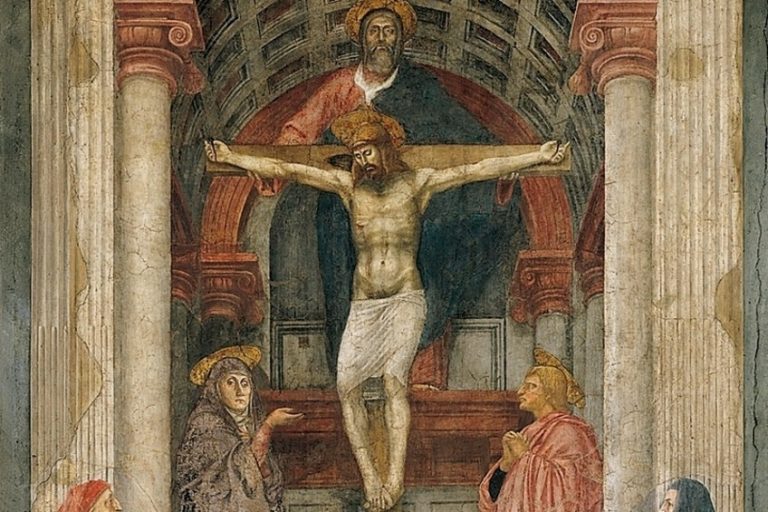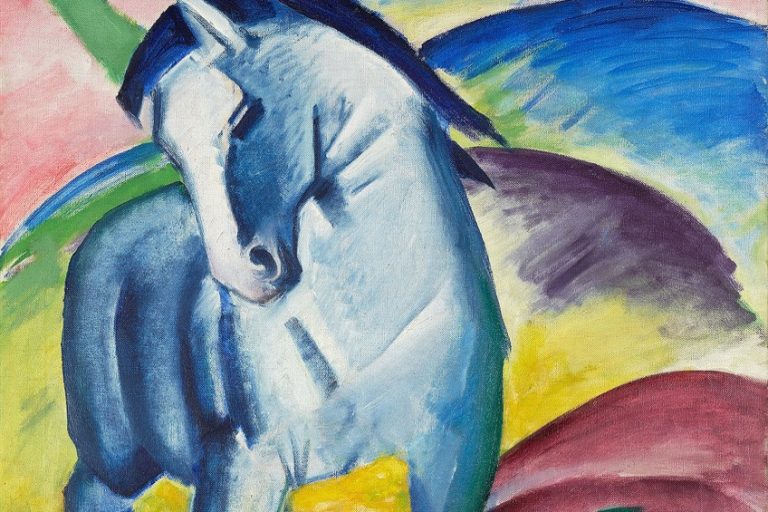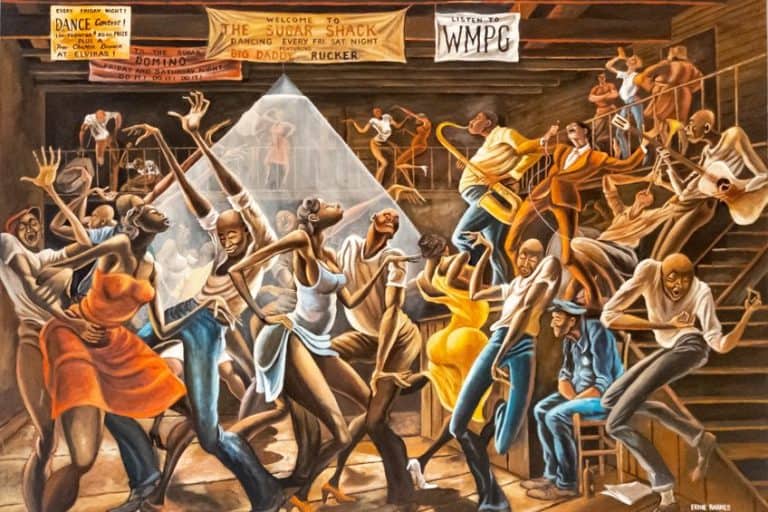“Las Hilanderas” by Diego Velázquez – An Artwork Analysis
Las Hilanderas, also known as The Spinners or The Fable of Arachne, is a masterful painting by the Spanish Baroque artist Diego Velázquez, created around 1657. This captivating work, housed in the Museo del Prado in Madrid, is celebrated for its intricate composition and sophisticated use of light and shadow. Velázquez ingeniously blends mythological themes with a realistic depiction of everyday life, illustrating the tale of Arachne, a mortal weaver who challenged the goddess Athena to a weaving contest. The painting’s foreground presents a bustling tapestry workshop, while the background reveals the mythological climax of Arachne’s transformation into a spider. Las Hilanderas is a testament to Velázquez’s skill in narrative art, his innovative use of space and perspective, and his ability to infuse genre scenes with profound allegorical meaning.
Key Takeaways
- Velázquez’s Las Hilanderas blends daily life with mythology.
- The painting is a prime example of 17th-century Spanish Baroque art.
- Velázquez’s techniques and themes influenced future generations.
Historical Context and Background
| Artist | Diego Velázquez (c. 1599 – 1660) |
|---|---|
| Date Created | c. 1657 |
| Medium | Oil on canvas |
| Genre | Genre painting and Mythological painting |
| Period/Movement | Baroque |
| Dimensions (cm) | 220 × 289 |
| Series/Versions | Single version |
| Where Is It Housed? | Museo del Prado, Madrid, Spain |
| What It Is Worth | Not publicly auctioned; extremely high cultural and historical value |
Las Hilanderas by Diego Velázquez captures the viewer’s attention with a dynamic scene of women engaged in the craft of spinning thread. This masterpiece, also known as The Fable of Arachne, showcases Velázquez’s ability to blend everyday life with mythological themes. Created in the mid-17th century, it remains one of the finest examples of Spanish Baroque painting and highlights the artist’s mastery of both light and composition.

The painting is renowned not only for its technical brilliance but also for its layered symbolism and storytelling. Featuring a backdrop that possibly references the myth of Arachne, Velázquez intertwines two temporal planes – the mythic past and contemporary reality – within the same canvas. This dual narrative invites viewers to look deeper into the significance behind each figure and their actions. Velázquez’s innovative approach in Las Hilanderas influenced many generations of artists and continues to be studied for its complex iconography and artistic techniques.
As an artifact from the Spanish Golden Age, it provides valuable insights into the cultural and social fabrics of 17th-century Spain.
Artist Profile: Diego Velázquez
Diego Velázquez, born in 1599 in Seville, was a prominent figure in the Spanish Baroque period. His early work was influenced by the chiaroscuro technique of the Italian Baroque style, which he encountered during his travels to Italy. By the time he painted Las Hilanderas, Velázquez had established himself as a master of complex compositions and subtle narrative layers. Serving as the court painter to King Philip IV, Velázquez enjoyed the patronage of the Spanish Royal Collection, enhancing his status and creative freedom. His works often went beyond mere portraiture, exploring mythological and genre subjects with profound depth.

Commission and Provenance
Las Hilanderas was likely created between 1655 and 1660, during the later years of Velázquez’s career. The commissioning details remain somewhat obscure, but it is believed Pedro de Arce, a hunting companion and steward to King Philip IV, might have played a significant role in its commission. The painting was initially housed in the Royal Alcazar of Madrid, underscoring its importance within the Spanish royal inventory. Following the destruction of the Royal Alcazar in a fire in 1734, the artwork was moved to the Museo del Prado, where it resides today.
This movement through various esteemed locations highlights the work’s enduring value and significance in the history of Spanish art.
Artistic Analysis
In Las Hilanderas, Velázquez showcases his mastery of technique through sophisticated layering, texture contrasts, and impactful use of color.

Subject Matter
Las Hilanderas, also known as The Spinners, portrays a group of women engaged in textile work. Central to the painting is a depiction of the mythological story of Arachne, who is seen competing with the goddess Athena in a weaving contest. The foreground features women actively spinning wool, while the background subtly integrates the mythological narrative.
This blend of contemporary and mythological elements creates depth and multiple layers of interpretation for the viewer.

Use of Line and Texture
Velázquez employs lines and textures to establish hierarchy and focus within the painting. The fine lines used for the spinning wheel and the delicate threads contrast with the rougher, more dynamic strokes in the background. Texture is particularly notable in the tapestry itself, which stands out with its intricate detailing, implying the skill and labor involved in its creation.
The artist’s ability to render various materials, from the softness of wool to the hardness of metal, adds to the painting’s realism.

Color Palette and Technique
The color palette of Las Hilanderas is rich in earth tones. Reds and browns dominate, providing a warm and cohesive look. These colors not only add to the realism but also set a somber, reflective mood. Velázquez’s technique involves the use of chiaroscuro, where light and shadow interplay to enhance the three-dimensionality of figures and objects.
This method highlights the contrast between the illuminated foreground and the shadowy, mysterious background.

Composition and Elements
The composition of Las Hilanderas is carefully constructed through a layered approach. The foreground, middleground, and background each contribute to the overall narrative. The arrangement of figures directs the viewer’s eye from the mundane reality of the spinners to the elevated mythological scene. Elements such as the tapestry provide symbolic depth and connect the different layers of the composition.
The Museo del Prado’s setting allows for the detailed observation of these intricate elements, emphasizing Velázquez’s skill in merging narrative and aesthetics.
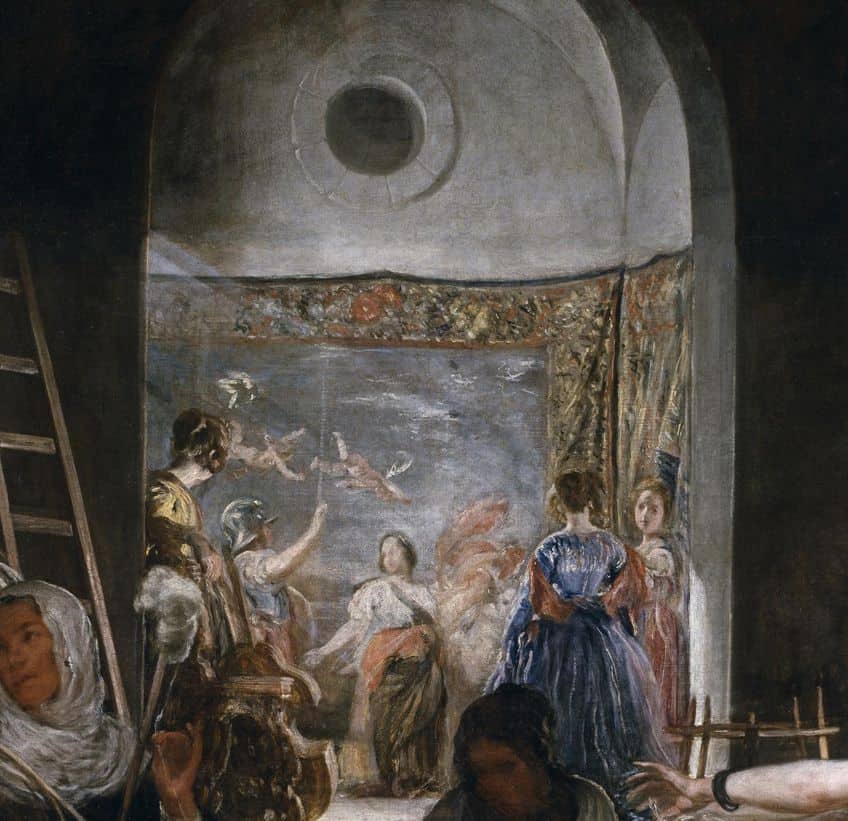
Symbolism and Iconography
Las Hilanderas is rich with layers of symbolism and iconography, weaving together elements from Greek mythology and the allegorical representation of contemporary life. The painting is widely believed to depict the mythological story of Arachne, as narrated by the Roman poet Ovid in his work, Metamorphoses. Arachne, a mortal woman, boasts of her weaving skills, claiming they surpass those of the goddess Athena.
Challenging Athena to a weaving contest, Arachne creates a tapestry that illustrates the divine indiscretions of the gods.
Athena’s response to Arachne’s hubris is significant. The goddess not only destroys Arachne’s work but transforms her into a spider, condemning her to weave for eternity. The inclusion of this mythological tale in the painting may serve to illustrate themes of divine retribution, pride, and the consequences of challenging higher powers. This myth engenders an intricate layer of meaning within the artwork.
Athena and the Weaving Contest
In Las Hilanderas, Velázquez masterfully incorporates Athena, the Greek goddess of wisdom and craftsmanship, central to the depicted myth. Athena’s presence in the background emphasizes the gravity of the contest between the divine and the mortal. The tension between Athena and Arachne is not just a personal conflict but a symbolic confrontation between human skill and divine authority.

The foreground of the painting presents women working in a tapestry workshop, creating a juxtaposition between the mundane and the mythological. This duality reflects the notion that everyday activities and divine myths are interconnected, suggesting that the mundane can bear profound symbolic significance. By embedding these elements, Velázquez enriches the viewer’s experience, prompting reflections on themes of talent, ambition, and the place of humanity within a grander cosmic order.
Legacy and Influence
Las Hilanderas has left an indelible mark on the art world through its intricate composition and storytelling. It holds significant importance when compared to contemporary works and has heavily influenced artists and periods that followed. Diego Velázquez’s Las Hilanderas is often compared to his other renowned work, Las Meninas. Both paintings use complex compositions and explore themes of reality versus illusion. Velázquez’s influence by Italian Baroque is evident, displaying the artist’s mastery in utilizing light and shadow. Additionally, the painting reflects the influences of Titian and Rubens, particularly in its dynamic motion and detailed tapestry depiction.
This alignment with other Baroque works underlines Velázquez’s ability to blend different styles seamlessly, further cementing his reputation as a master painter of his time.
Impact on Later Artists and Periods
Velázquez’s Las Hilanderas significantly impacted subsequent artists and art periods. Johannes Vermeer, who created The Art of Painting, drew inspiration from Velázquez’s use of light and domestic scenes. The tapestry depiction in Las Hilanderas also inspired later artists such as Peter Paul Rubens, particularly in works like The Rape of Europa. Francisco Goya and other Spanish artists of the 18th and 19th centuries often cited Velázquez’s innovative techniques and storytelling prowess. The painting’s intricate layers and mythological elements resonated deeply, influencing how stories were depicted in art for generations.
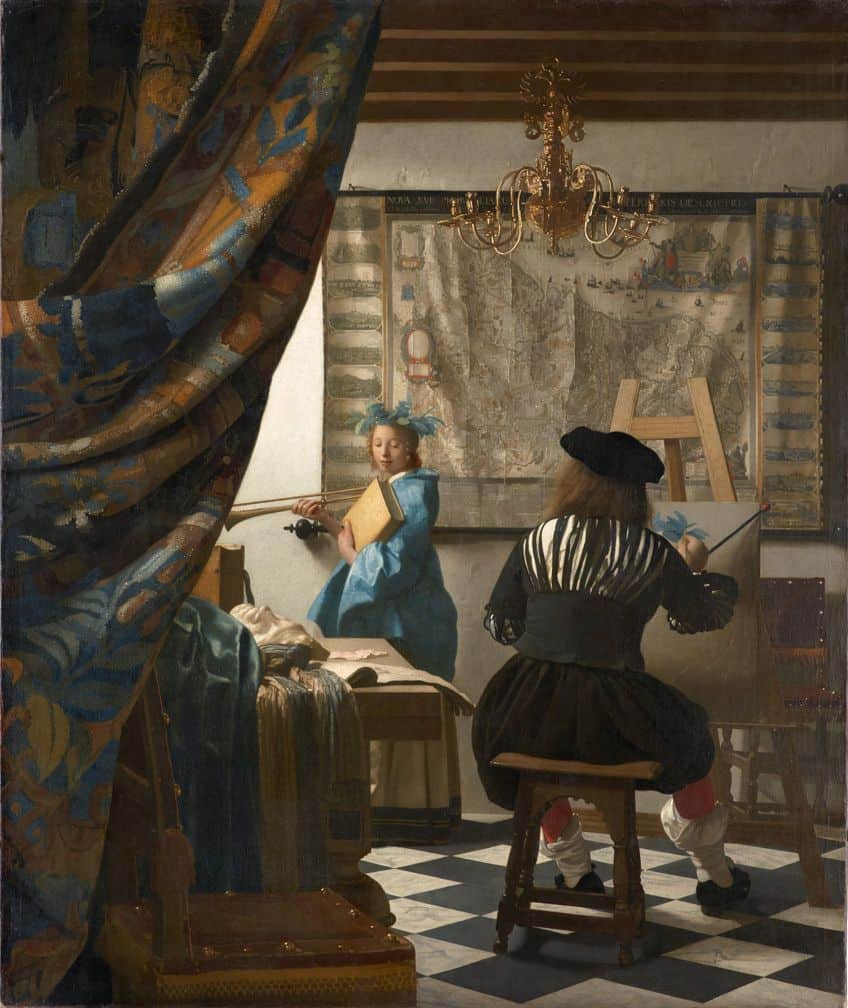
Legacy of Las Hilanderas Today
Today, Las Hilanderas holds a prominent place in the Museo del Prado in Madrid, where it continues to attract art lovers and scholars. The painting is celebrated for its technical brilliance and narrative depth. Its influence is seen in contemporary depictions of mythological themes and the use of light. Art education often references Las Hilanderas, analyzing its composition, theme, and historical significance. Its legacy persists as a testament to Velázquez’s unparalleled contribution to the arts, ensuring its place in art history remains assured.
Las Hilanderas stands as a testament to Diego Velázquez’s extraordinary ability to weave together myth and reality within a single canvas. Through his masterful technique, Velázquez captures the dynamic energy of the tapestry workshop while subtly conveying the dramatic myth of Arachne, blending the mundane with the divine. The painting’s sophisticated composition, use of light, and intricate detailing reflect Velázquez’s deep understanding of human expression and storytelling. Las Hilanderas not only showcases the artist’s technical prowess but also his innovative approach to narrative art, making it a quintessential work that continues to captivate and inspire viewers and scholars alike.
Frequently Asked Questions
What Themes Are Depicted in Las Hilanderas?
Las Hilanderas showcases themes of labor, artistry, and mythology. Central to the painting is the competition between Arachne and Pallas Athena, representing human skill versus divine power. The foreground depicts women spinning wool, emphasizing everyday labor, while the background hints at the mythological tale, blending reality with legend.
How Does Las Hilanderas Reflect Velázquez’s Painting Style?
The painting demonstrates Velázquez’s mastery of naturalism and his ability to capture textures, light, and perspective. His use of loose brushwork and a limited, muted color palette contributes to the lifelike quality of the figures. Velázquez skillfully integrates different layers of space, creating depth and a sense of continuity between the foreground and background.
What Historical or Mythological References Are Present in Las Hilanderas?
Las Hilanderas references the story of Arachne from Ovid’s Metamorphoses. Arachne, a talented weaver, challenged the goddess Pallas Athena to a weaving contest, resulting in her transformation into a spider. This mythological narrative is subtly embedded in the background, serving as an allegory for artistic rivalry and punishment.
How Has Las Hilanderas Influenced the Art World?
The painting has been studied for its complex composition and thematic depth. It has influenced later artists and scholars, who appreciate Velázquez’s innovative approach to combining genre scenes with mythological content. Las Hilanderas continues to be a focal point in discussions about Baroque art and the depiction of myth within a realist framework.
Isabella studied at the University of Cape Town in South Africa and graduated with a Bachelor of Arts majoring in English Literature & Language and Psychology. Throughout her undergraduate years, she took Art History as an additional subject and absolutely loved it. Building on from her art history knowledge that began in high school, art has always been a particular area of fascination for her. From learning about artworks previously unknown to her, or sharpening her existing understanding of specific works, the ability to continue learning within this interesting sphere excites her greatly.
Her focal points of interest in art history encompass profiling specific artists and art movements, as it is these areas where she is able to really dig deep into the rich narrative of the art world. Additionally, she particularly enjoys exploring the different artistic styles of the 20th century, as well as the important impact that female artists have had on the development of art history.
Learn more about Isabella Meyer and the Art in Context Team.
Cite this Article
Isabella, Meyer, ““Las Hilanderas” by Diego Velázquez – An Artwork Analysis.” Art in Context. June 25, 2024. URL: https://artincontext.org/las-hilanderas-by-diego-velazquez/
Meyer, I. (2024, 25 June). “Las Hilanderas” by Diego Velázquez – An Artwork Analysis. Art in Context. https://artincontext.org/las-hilanderas-by-diego-velazquez/
Meyer, Isabella. ““Las Hilanderas” by Diego Velázquez – An Artwork Analysis.” Art in Context, June 25, 2024. https://artincontext.org/las-hilanderas-by-diego-velazquez/.


